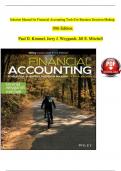Exam (elaborations)
Solution Manual for Financial Accounting Tools For Business Decision Making, 10th Edition, Paul D. Kimmel, Jerry J. Weygandt | Verified Chapters 1 - 13 | Complete Newest Version
Solution Manual for Financial Accounting Tools For Business Decision Making, 10th Edition, Paul D. Kimmel, Jerry J. Weygandt | Verified Chapters 1 - 13 | Complete Newest Version Solution Manual for Financial Accounting Tools For Business Decision Making, 10th Edition, Paul D. Kimmel, Jerry J. Wey...
[Show more]



